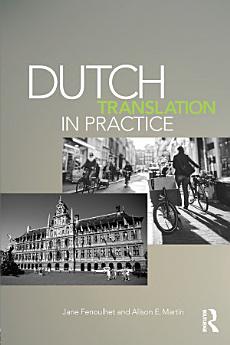Dutch Translation in Practice
តុលា 2014 · Routledge
5.0star
ការវាយតម្លៃ 1report
សៀវភៅអេឡិចត្រូនិច
198
ទំព័រ
family_home
មានសិទ្ធិ
info
reportការវាយតម្លៃ និងមតិវាយតម្លៃមិនត្រូវបានផ្ទៀងផ្ទាត់ទេ ស្វែងយល់បន្ថែម
អំពីសៀវភៅអេឡិចត្រូនិកនេះ
Dutch Translation in Practice provides an accessible and engaging course in modern Dutch translation. Taking a highly practical approach, it introduces students to the essential concepts of translation studies, heightens their awareness of the problems posed in Dutch translation, and teaches them how to tackle these difficulties successfully. Featured texts have been carefully chosen for their thematic and technical relevance, and a wide range of discursive and grammatical issues are covered throughout.
Features include:
- Nine chapters reflecting different areas of contemporary life and culture in Belgium and the Netherlands such as People and Places, Dutch Language and Culture, Literature, Employment, Finance and Economics, Media and Communications, Art History and Exhibitions, Fashion and Design and the Earth, Energy and the Environment
- Authentic extracts drawn from up-to-date Dutch texts used throughout to illustrate and practise various topical and translation issues, with many supporting exercises and open translation activities to encourage active engagement with the material, the development of strong translation skills, and vocabulary acquisition
- Chapters structured to provide progressive learning, moving from an introductory section explaining the context for the texts to be translated to information on translation techniques, detailed close readings and analyses of words, phrases, style, register and tone
- A strong focus throughout on addressing issues relevant to contemporary Dutch translation, with practical tips offered for translating websites, dealing with names and handling statistics and numbers in translation
- Attention to language areas of particular difficulty, including translating ‘er’, passive constructions, punctuation, conjunctions and separable verbs
- Helpful list of grammatical terms, information on useful resources for translators and sample translations of texts available at the back of the book
Written by experienced instructors and extensively trialled at University College London, Dutch Translation in Practice will be an essential resource for students on upper-level undergraduate, postgraduate or professional courses in Dutch and Translation Studies.
ការដាក់ផ្កាយ និងមតិវាយតម្លៃ
5.0
ការវាយតម្លៃ 1
អំពីអ្នកនិពន្ធ
Jane Fenoulhet is Professor of Dutch Studies at University College London, UK.
Alison E. Martin is Lecturer in German Studies at the University of Reading, UK.
វាយតម្លៃសៀវភៅអេឡិចត្រូនិកនេះ
ប្រាប់យើងអំពីការយល់ឃើញរបស់អ្នក។
អានព័ត៌មាន
ទូរសព្ទឆ្លាតវៃ និងថេប្លេត
ដំឡើងកម្មវិធី Google Play Books សម្រាប់ Android និង iPad/iPhone ។ វាធ្វើសមកាលកម្មដោយស្វ័យប្រវត្តិជាមួយគណនីរបស់អ្នក និងអនុញ្ញាតឱ្យអ្នកអានពេលមានអ៊ីនធឺណិត ឬគ្មានអ៊ីនធឺណិតនៅគ្រប់ទីកន្លែង។
កុំព្យូទ័រយួរដៃ និងកុំព្យូទ័រ
អ្នកអាចស្ដាប់សៀវភៅជាសំឡេងដែលបានទិញនៅក្នុង Google Play ដោយប្រើកម្មវិធីរុករកតាមអ៊ីនធឺណិតក្នុងកុំព្យូទ័ររបស់អ្នក។
eReaders និងឧបករណ៍ផ្សេងទៀត
ដើម្បីអាននៅលើឧបករណ៍ e-ink ដូចជាឧបករណ៍អានសៀវភៅអេឡិចត្រូនិក Kobo អ្នកនឹងត្រូវទាញយកឯកសារ ហើយផ្ទេរវាទៅឧបករណ៍របស់អ្នក។ សូមអនុវត្តតាមការណែនាំលម្អិតរបស់មជ្ឈមណ្ឌលជំនួយ ដើម្បីផ្ទេរឯកសារទៅឧបករណ៍អានសៀវភៅអេឡិចត្រូនិកដែលស្គាល់។






